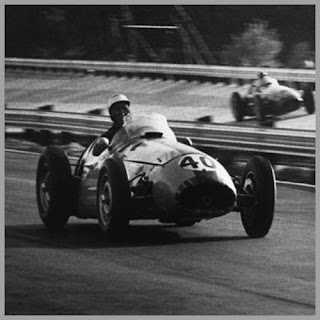 | |
|
In 1939, he travelled to Europe and saw the last car race at Brooklands before the outbreak of World War II. During the war he flew fighter planes for the Allies, including the A-20 Havoc and the P-51 Mustang, becoming one of the only pilots to shoot down the deadly Messerschmidt ME 262 Jet Fighter.
When John returned to the U.S., he was among the many young pilots who'd developed the need for speed during the war and turned to auto racing. But unlike many of his contemporaries, Fitch was good. So good, in fact, that he caught the eye of Briggs Cunningham, the wealthy racing enthusiast who encouraged Fitch to enter and win the 1951 Grand Prix of Argentina, in a car John prepared himself. This win clinched the support of Cunningham, who accepted him onto his racing team, for which John scored a number of impressive victories in the early '50s, at then-fledgling road courses like Elkhart Lake and Watkins Glen. But Cunningham had bigger plans: His goal was to win Le Mans, the world's most demanding endurance race, with an American car and driver, and Fitch was to play a leading role in that quest. In 1952, he came close to making Cunningham's dream come true. After setting fastest lap in his C-4R roadster, he was forced to retire late in the race because of ‘bad fuel.’
This event gave John a chance at something bigger. John convinced Mercedes team chief engineer Rudi Uhlenhaut to allow him to take several Mercedes 300 SLs to the upcoming Carrera Panamericana, a race that wasn't even on Neubauer's radar. His performance during the race secured him a spot on the Mercedes team, driving with the likes of Juan Manuel Faigio and Stirling Moss. John proceeded to compete successfully in many notable races for these teams, including several seasons of both the 24 Hours of Le Mans and 12 Hours of Sebring, and other races like the Mille Miglia in 1953 and 1955, and the RAC Tourists Trophy in 1955, as well as the ’53 and ’55 Seasons of Formula One.
But John’s racing career didn't end there, because at the end of 1955, Chevrolet's Chief Engineer, Ed Cole suggested that he help develop the Corvette into a world-class race car and manage a team of Corvettes he planned to enter at Sebring, just six weeks away. Many thought that it would be impossible to make the slow, overweight production two-seaters competitive in such a short amount of time, but in typical fashion, John rose to the occasion. Four cars were entered in two different classes but against overwhelming odds, the team won both classes, earning them the team prize and setting the foundation for the Corvette Racing Team that still performs to this day.
 |
John Fitch racing at Monza in the Italian
|
John retired from racing in 1964 to his home in Connecticut, where he lived with his wife Elizabeth and their three sons, John, Christopher (Kip) and Stephen. John continued to drive in vintage racing events, particularly at Lime Rock Park, and even returned to racing at 87 years of age, trying to set a land speed record in a 50-year-old Mercedes-Benz 300 SL owned by Bob Sirna at the Bonneville Salt Flats.
John was the definition of an Auto Enthusiast and I was Lucky enough to spend time with him, both professionally and as friends. Unfortunately we lost this shining star to Cancer in 2012, but his spirit will live on in the hearts and memories of those who new him and followed his career with fondness. On numerous occasions he displayed his great admiration of Cars and Motorsports and always maintained a jubilant attitude with family and friends, and towards life in general. I am sure that he influenced many people who looked up to him and I will always remember him fondly.
Adieu John,
Jacques Vaucher
Owner
l’art de l’automobile
Make sure to head to our site at Arteauto.com or check out a newly acquired collection from John's personal Library
No comments:
Post a Comment